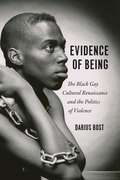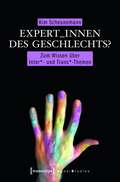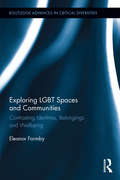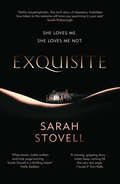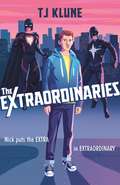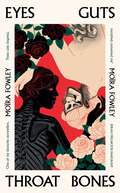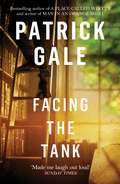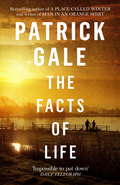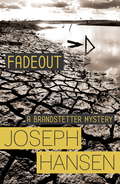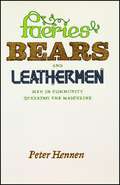- Table View
- List View
Evidence of Being: The Black Gay Cultural Renaissance and the Politics of Violence
by Darius BostEvidence of Being opens on a grim scene: Washington DC’s gay black community in the 1980s, ravaged by AIDS, the crack epidemic, and a series of unsolved murders, seemingly abandoned by the government and mainstream culture. Yet in this darkest of moments, a new vision of community and hope managed to emerge. Darius Bost’s account of the media, poetry, and performance of this time and place reveals a stunning confluence of activism and the arts. In Washington and New York during the 1980s and ’90s, gay black men banded together, using creative expression as a tool to challenge the widespread views that marked them as unworthy of grief. They created art that enriched and reimagined their lives in the face of pain and neglect, while at the same time forging a path toward bold new modes of existence. At once a corrective to the predominantly white male accounts of the AIDS crisis and an openhearted depiction of the possibilities of black gay life, Evidence of Being above all insists on the primacy of community over loneliness, and hope over despair.
Evidence of Being: The Black Gay Cultural Renaissance and the Politics of Violence
by Darius BostEvidence of Being opens on a grim scene: Washington DC’s gay black community in the 1980s, ravaged by AIDS, the crack epidemic, and a series of unsolved murders, seemingly abandoned by the government and mainstream culture. Yet in this darkest of moments, a new vision of community and hope managed to emerge. Darius Bost’s account of the media, poetry, and performance of this time and place reveals a stunning confluence of activism and the arts. In Washington and New York during the 1980s and ’90s, gay black men banded together, using creative expression as a tool to challenge the widespread views that marked them as unworthy of grief. They created art that enriched and reimagined their lives in the face of pain and neglect, while at the same time forging a path toward bold new modes of existence. At once a corrective to the predominantly white male accounts of the AIDS crisis and an openhearted depiction of the possibilities of black gay life, Evidence of Being above all insists on the primacy of community over loneliness, and hope over despair.
Evidence of Being: The Black Gay Cultural Renaissance and the Politics of Violence
by Darius BostEvidence of Being opens on a grim scene: Washington DC’s gay black community in the 1980s, ravaged by AIDS, the crack epidemic, and a series of unsolved murders, seemingly abandoned by the government and mainstream culture. Yet in this darkest of moments, a new vision of community and hope managed to emerge. Darius Bost’s account of the media, poetry, and performance of this time and place reveals a stunning confluence of activism and the arts. In Washington and New York during the 1980s and ’90s, gay black men banded together, using creative expression as a tool to challenge the widespread views that marked them as unworthy of grief. They created art that enriched and reimagined their lives in the face of pain and neglect, while at the same time forging a path toward bold new modes of existence. At once a corrective to the predominantly white male accounts of the AIDS crisis and an openhearted depiction of the possibilities of black gay life, Evidence of Being above all insists on the primacy of community over loneliness, and hope over despair.
Evidence of Being: The Black Gay Cultural Renaissance and the Politics of Violence
by Darius BostEvidence of Being opens on a grim scene: Washington DC’s gay black community in the 1980s, ravaged by AIDS, the crack epidemic, and a series of unsolved murders, seemingly abandoned by the government and mainstream culture. Yet in this darkest of moments, a new vision of community and hope managed to emerge. Darius Bost’s account of the media, poetry, and performance of this time and place reveals a stunning confluence of activism and the arts. In Washington and New York during the 1980s and ’90s, gay black men banded together, using creative expression as a tool to challenge the widespread views that marked them as unworthy of grief. They created art that enriched and reimagined their lives in the face of pain and neglect, while at the same time forging a path toward bold new modes of existence. At once a corrective to the predominantly white male accounts of the AIDS crisis and an openhearted depiction of the possibilities of black gay life, Evidence of Being above all insists on the primacy of community over loneliness, and hope over despair.
Evidence of Being: The Black Gay Cultural Renaissance and the Politics of Violence
by Darius BostEvidence of Being opens on a grim scene: Washington DC’s gay black community in the 1980s, ravaged by AIDS, the crack epidemic, and a series of unsolved murders, seemingly abandoned by the government and mainstream culture. Yet in this darkest of moments, a new vision of community and hope managed to emerge. Darius Bost’s account of the media, poetry, and performance of this time and place reveals a stunning confluence of activism and the arts. In Washington and New York during the 1980s and ’90s, gay black men banded together, using creative expression as a tool to challenge the widespread views that marked them as unworthy of grief. They created art that enriched and reimagined their lives in the face of pain and neglect, while at the same time forging a path toward bold new modes of existence. At once a corrective to the predominantly white male accounts of the AIDS crisis and an openhearted depiction of the possibilities of black gay life, Evidence of Being above all insists on the primacy of community over loneliness, and hope over despair.
Evidence of Being: The Black Gay Cultural Renaissance and the Politics of Violence
by Darius BostEvidence of Being opens on a grim scene: Washington DC’s gay black community in the 1980s, ravaged by AIDS, the crack epidemic, and a series of unsolved murders, seemingly abandoned by the government and mainstream culture. Yet in this darkest of moments, a new vision of community and hope managed to emerge. Darius Bost’s account of the media, poetry, and performance of this time and place reveals a stunning confluence of activism and the arts. In Washington and New York during the 1980s and ’90s, gay black men banded together, using creative expression as a tool to challenge the widespread views that marked them as unworthy of grief. They created art that enriched and reimagined their lives in the face of pain and neglect, while at the same time forging a path toward bold new modes of existence. At once a corrective to the predominantly white male accounts of the AIDS crisis and an openhearted depiction of the possibilities of black gay life, Evidence of Being above all insists on the primacy of community over loneliness, and hope over despair.
Ex-Gay Research: Analyzing the Spitzer Study and Its Relation to Science, Religion, Politics, and Culture
by Jack Drescher Kenneth J ZuckerDefenders and critics of the controversial Spitzer study analyze its methodologies and findingsIn 2001, Robert L. Spitzer, MD, presented his study on sexual conversion therapy with its controversial findings that some homosexuals can change their sexual orientation. The resulting media sensation and political firestorm enraged the study&’s critics and emboldened its supporters. Ex-Gay Research: Analyzing the Spitzer Study and Its Relation to Science, Religion, Politics, and Culture presents leading experts examining Spitzer&’s research methodology and findings to discern whether the study itself deserves deeper consideration or outright dismissal. Every facet of the study is reviewed to discuss the positive or negative aspects of the results, its significance in political and social terms, and the implications for the future. Dr. Spitzer himself was an instrumental figure in the American Psychiatric Association's decision in 1973 to remove homosexuality as a mental illness listing from the Diagnostic and Statistical Manual-III. His later study that states that in some individuals, homosexuality may be more fluid than previously thought stirred controversy in the psychiatric community and society at large. His study is presented here to allow the reader to evaluate and consider it for themselves. Leading experts then voice their own pro or con views on the methodology and findings. Ex-Gay Research: Analyzing the Spitzer Study and Its Relation to Science, Religion, Politics, and Culture fearlessly illustrates the sometimes fuzzy boundary between science and politics, courageously spotlighting the culture wars now dividing our society.Ex-Gay Research: Analyzing the Spitzer Study and Its Relation to Science, Religion, Politics, and Culture discusses: the ex-gay movement the nature of scientific inquiry the relationship between science and politics the results of sexual conversion therapies gay and lesbian rightsEx-Gay Research: Analyzing the Spitzer Study and Its Relation to Science, Religion, Politics, and Culture is essential reading for sex researchers, mental health professionals, pastoral counselors, political activists, and any person asking if one can truly "change" his or her homosexuality.
Ex-Gay Research: Analyzing the Spitzer Study and Its Relation to Science, Religion, Politics, and Culture
by Jack Drescher Kenneth J ZuckerDefenders and critics of the controversial Spitzer study analyze its methodologies and findingsIn 2001, Robert L. Spitzer, MD, presented his study on sexual conversion therapy with its controversial findings that some homosexuals can change their sexual orientation. The resulting media sensation and political firestorm enraged the study&’s critics and emboldened its supporters. Ex-Gay Research: Analyzing the Spitzer Study and Its Relation to Science, Religion, Politics, and Culture presents leading experts examining Spitzer&’s research methodology and findings to discern whether the study itself deserves deeper consideration or outright dismissal. Every facet of the study is reviewed to discuss the positive or negative aspects of the results, its significance in political and social terms, and the implications for the future. Dr. Spitzer himself was an instrumental figure in the American Psychiatric Association's decision in 1973 to remove homosexuality as a mental illness listing from the Diagnostic and Statistical Manual-III. His later study that states that in some individuals, homosexuality may be more fluid than previously thought stirred controversy in the psychiatric community and society at large. His study is presented here to allow the reader to evaluate and consider it for themselves. Leading experts then voice their own pro or con views on the methodology and findings. Ex-Gay Research: Analyzing the Spitzer Study and Its Relation to Science, Religion, Politics, and Culture fearlessly illustrates the sometimes fuzzy boundary between science and politics, courageously spotlighting the culture wars now dividing our society.Ex-Gay Research: Analyzing the Spitzer Study and Its Relation to Science, Religion, Politics, and Culture discusses: the ex-gay movement the nature of scientific inquiry the relationship between science and politics the results of sexual conversion therapies gay and lesbian rightsEx-Gay Research: Analyzing the Spitzer Study and Its Relation to Science, Religion, Politics, and Culture is essential reading for sex researchers, mental health professionals, pastoral counselors, political activists, and any person asking if one can truly "change" his or her homosexuality.
Excluded: Making Feminist and Queer Movements More Inclusive
by Julia SeranoA transformational approach to overcoming the divisions between feminist communities While many feminist and queer movements are designed to challenge sexism, they often simultaneously police gender and sexuality--sometimes just as fiercely as the straight, male-centric mainstream does. Some feminists vocally condemn other feminists because of how they dress, for their sexual partners or practices, or because they are seen as different and therefore less valued. Among LGBTQ activists, there is a long history of lesbians and gay men dismissing bisexuals, transgender people, and other gender and sexual minorities. In each case, exclusion is based on the premise that certain ways of being gendered or sexual are more legitimate, natural, or righteous than others.As a trans woman, bisexual, and femme activist, Julia Serano has spent much of the last ten years challenging various forms of exclusion within feminist and queer/LGBTQ movements. In Excluded, she chronicles many of these instances of exclusion and argues that marginalizing others often stems from a handful of assumptions that are routinely made about gender and sexuality. These false assumptions infect theories, activism, organizations, and communities--and worse, they enable people to vigorously protest certain forms of sexism while simultaneously ignoring and even perpetuating others. Serano advocates for a new approach to fighting sexism that avoids these pitfalls and offers new ways of thinking about gender, sexuality, and sexism that foster inclusivity.
Excluded: Making Feminist and Queer Movements More Inclusive
by Julia SeranoA transformational approach to overcoming the divisions between feminist communities While many feminist and queer movements are designed to challenge sexism, they often simultaneously police gender and sexuality -- sometimes just as fiercely as the straight, male-centric mainstream does. Some feminists vocally condemn other feminists because of how they dress, for their sexual partners or practices, or because they are seen as different and therefore less valued. Among LGBTQ activists, there is a long history of lesbians and gay men dismissing bisexuals, transgender people, and other gender and sexual minorities. In each case, exclusion is based on the premise that certain ways of being gendered or sexual are more legitimate, natural, or righteous than others. As a trans woman, bisexual, and femme activist, Julia Serano has spent much of the last ten years challenging various forms of exclusion within feminist and queer/LGBTQ movements. In Excluded, she chronicles many of these instances of exclusion and argues that marginalizing others often stems from a handful of assumptions that are routinely made about gender and sexuality. These false assumptions infect theories, activism, organizations, and communities -- and worse, they enable people to vigorously protest certain forms of sexism while simultaneously ignoring and even perpetuating others. Serano advocates for a new approach to fighting sexism that avoids these pitfalls and offers new ways of thinking about gender, sexuality, and sexism that foster inclusivity.
The Exhibitionist: The Times Novel of the Year
by Charlotte Mendelson'It takes the most ferocious intelligence, skill, and a deep reservoir of sadness to write a novel as funny as this. I adored it' - MEG MASON'A devastating treat of a novel: funny, furious, dark and delicious' - SARAH WATERSThe longer the marriage, the harder truth becomes . . . Meet the Hanrahan family, gathering for a momentous weekend as famous artist and notorious egoist Ray Hanrahan prepares for a new exhibition of his art – the first in many decades – and one he is sure will burnish his reputation for good. His three children will be there: beautiful Leah, always her father’s biggest champion; sensitive Patrick, who has finally decided to strike out on his own; and insecure Jess, the youngest, who has her own momentous decision to make . . . And what of Lucia, Ray’s steadfast and selfless wife? She is an artist, too, but has always had to put her roles as wife and mother first. What will happen if she decides to change? For Lucia is hiding secrets of her own, and as the weekend unfolds and the exhibition approaches, she must finally make a choice.The Exhibitionist is the extraordinary fifth novel from Charlotte Mendelson, a dazzling exploration of art, sacrifice, toxic family politics, queer desire, and personal freedom. 'Delicious, heartbreaking . . . Fabulously written and utterly compelling' - MARIAN KEYES
Experienced
by null Kate Young'Clever, sexy and joyful. I loved it' BETH O'LEARY 'A fizzing roller-coaster of a rom-com. The sexiest book you'll read all year and the most heartening’ CAROLINE O'DONOGHUE ‘A very relatable take on love that will pull at your heartstrings’ RED Bette loves Mei, but Bette and Mei are on a break, so Bette can catch-up on the decade of dating experiences she missed before she came out. So Bette is (reluctantly) on a dating odyssey: a quest to have lots of casual sex with lots of hot women and come back to Mei more experienced and more certain about what she wants. And now she has new friend Ruth as her dating guide, she can't possibly fail. It's just three months, then she'll be back with Mei. It's the perfect plan … isn't it? What readers are saying about Experienced… ‘An absolutely perfect romcom’ ⭐ ⭐ ⭐ ⭐ ⭐ ‘More bonking than Jilly Cooper’ ⭐ ⭐ ⭐ ⭐ ⭐ ‘384 pages of pure joy and heartbreak’ ⭐ ⭐ ⭐ ⭐ ⭐ ‘Phenomenal! Fun, sexy, big recommend’ ⭐ ⭐ ⭐ ⭐ ⭐ ‘I feel bereft now I’ve finished’ ⭐ ⭐ ⭐ ⭐ ⭐
An Experiment in Leisure
by Anna Glendenning'I adore this book! ... An Experiment in Leisure shows us the burning, intense, messy beauty of youth and what it means to be alive' Maxine Peake 'Can I get a refund?' I asked the bus driver. 'You taking the piss, love?' It's January 2015, and Grace is supposed to have what she wants. She's swapped West Yorkshire for north London, her accent carefully edited and with a Cambridge degree under her belt. Her friends drink beer out of artful tins. She makes flat whites for people with berets. She's found a psychoanalyst. But this fantasy of metropolitan cool is turning out to be more costly than she thought, and Grace is running out of credit. Painfully adrift from her mother and twin sister and trying desperately both to forget her roots and disown her ambition, she's lost and confused in the face of complicated crises of identity, class, sex and geography. She finds herself fleeing up and down a country on the verge of an intractable schism, and begins to reckon with her own divisions. Can she find a life amid these contradictions? Can she remember how to love?'A dizzying yet powerful read' Claire-Louise Bennett
Experimental Film and Queer Materiality
by Juan A. Su?rezOften described as an art of abstraction and subjective introspection, experimental film is also invested in exploring daily objects and materials and in channeling, in the process, a peculiar perception of the modern everyday that this book calls queer materiality. Queer materiality designates the queer latency of modern material culture, which often inspired queer artists and filmmakers to envision wayward bodies and behaviors, and refers to the way in which sexual and social dissidence was embedded in the objects, technologies, substances, and spaces that make up the hardware of experience. This book studies a rich archive of queer material engagements in work by well-known filmmakers such as Andy Warhol, Barbara Hammer, Carolee Schneemann, and Jack Smith as well as under-recognized figures such as Tom Chomont, Jim Hubbard, Ashley Hans Scheirl, and Teo Hern?ndez. Combining history, formal analysis, and theoretical reflection, author Juan A. Su?rez shows how plastics, glitter, mechanical ensembles, urban ruins, garbage, amphetamine, film grain, and noise have been mobilized in the articulation of queerness for the screen. Experimental Film and Queer Materiality is an inquiry into the liveliness of matter and into the interface between sexuality and the material world.
Experimental Film and Queer Materiality
by Juan A. Su?rezOften described as an art of abstraction and subjective introspection, experimental film is also invested in exploring daily objects and materials and in channeling, in the process, a peculiar perception of the modern everyday that this book calls queer materiality. Queer materiality designates the queer latency of modern material culture, which often inspired queer artists and filmmakers to envision wayward bodies and behaviors, and refers to the way in which sexual and social dissidence was embedded in the objects, technologies, substances, and spaces that make up the hardware of experience. This book studies a rich archive of queer material engagements in work by well-known filmmakers such as Andy Warhol, Barbara Hammer, Carolee Schneemann, and Jack Smith as well as under-recognized figures such as Tom Chomont, Jim Hubbard, Ashley Hans Scheirl, and Teo Hern?ndez. Combining history, formal analysis, and theoretical reflection, author Juan A. Su?rez shows how plastics, glitter, mechanical ensembles, urban ruins, garbage, amphetamine, film grain, and noise have been mobilized in the articulation of queerness for the screen. Experimental Film and Queer Materiality is an inquiry into the liveliness of matter and into the interface between sexuality and the material world.
Expert_innen des Geschlechts?: Zum Wissen über Inter*- und Trans*-Themen (Queer Studies #16)
by Kim ScheunemannMuss eine Person Inter* oder Trans* sein, um als Expert_in für Inter*- oder Trans*themen anerkannt zu werden? Oder darf sie dies auf keinen Fall, da sie ›objektiv‹ sein muss? Und welche (Gefühls-)Arbeit müssen Expert_innen des Geschlechts alltäglich leisten, um im eigenen Geschlecht und/oder als Expert_in anerkannt zu werden? Verliert der professionelle Expert_innenstatus zunehmend an Deutungsmacht? Anhand von Interviews mit Aktivist_innen und Therapeut_innen räumt Kim Scheunemann mit dem Vorurteil auf, dass ausschließlich Inter*-oder Trans*personen sich mit Geschlecht auseinandersetzen (müssen) und stellt in Frage, ob es objektive Expert_innen des Geschlechtes überhaupt geben kann.
Exploring LGBT Spaces and Communities: Contrasting Identities, Belongings and Wellbeing (Routledge Advances in Critical Diversities)
by Eleanor FormbyThe phrase ‘LGBT community’ is often used by policy-makers, service providers, and lesbian, gay, bisexual and trans (LGBT) people themselves, but what does it mean? What understandings and experiences does that term suggest, and ignore? Based on a UK-wide study funded by the Arts and Humanities Research Council, this book explores these questions from the perspectives of over 600 research participants. Examining ideas about community ‘ownership’; ‘difference’ and diversity; relational practices within and beyond physical spaces; imagined communities and belongings; the importance of ‘ritual’ spaces and symbols, and consequences for wellbeing, the book foregrounds the lived experience of LGBT people to offer a broad analysis of commonalities and divergences in relation to LGBT identities. Drawing on an interdisciplinary perspective grounded in international social science research, the book will appeal to students and scholars with interests in sexual and/or gender identities in the fields of community studies, cultural studies, gender studies, geography, leisure studies, politics, psychology, sexuality studies, social policy, social work, socio-legal studies, and sociology. The book also offers implications for practice, suitable for policy-maker, practitioner, and activist audiences, as well as those with a more personal interest.
Exploring LGBT Spaces and Communities: Contrasting Identities, Belongings and Wellbeing (Routledge Advances in Critical Diversities)
by Eleanor FormbyThe phrase ‘LGBT community’ is often used by policy-makers, service providers, and lesbian, gay, bisexual and trans (LGBT) people themselves, but what does it mean? What understandings and experiences does that term suggest, and ignore? Based on a UK-wide study funded by the Arts and Humanities Research Council, this book explores these questions from the perspectives of over 600 research participants. Examining ideas about community ‘ownership’; ‘difference’ and diversity; relational practices within and beyond physical spaces; imagined communities and belongings; the importance of ‘ritual’ spaces and symbols, and consequences for wellbeing, the book foregrounds the lived experience of LGBT people to offer a broad analysis of commonalities and divergences in relation to LGBT identities. Drawing on an interdisciplinary perspective grounded in international social science research, the book will appeal to students and scholars with interests in sexual and/or gender identities in the fields of community studies, cultural studies, gender studies, geography, leisure studies, politics, psychology, sexuality studies, social policy, social work, socio-legal studies, and sociology. The book also offers implications for practice, suitable for policy-maker, practitioner, and activist audiences, as well as those with a more personal interest.
Exquisite
by Sarah StovellShe loves me. She loves me not.Bo Luxton has it all – a loving family, a beautiful home in the Lake District, and a clutch of bestselling books to her name.Enter Alice Dark, an aspiring writer who is drifting through life, with a series of dead-end jobs and a freeloading boyfriend.When they meet at a writers’ retreat, the chemistry is instant, and a sinister relationship develops…Or does it?Breathlessly pacey, taut and terrifying, Exquisite is a startlingly original and unbalancing psychological thriller that will keep you guessing until the very last page.‘The characters are so untrustworthy you wont know what to believe, but you won’t put it down till you’ve found out. A superb debut’ Sunday Mirror'Cunningly constructed and gorgeously written, this is outstanding’ Express'It’s a remarkable debut in the crowded psychological thriller field, written with great sureness of touch and tone' Times Crime Club‘Slickly claustrophobic, this arch story of obsessive, forbidden love taken to the extreme will have you squirming in your seat’ Sarah Pinsborough‘Whip-smart, lushly written and truly page-turning … Sarah Stovell is a thrilling talent’ Holly Seddon‘A moving, gripping story … twists keep coming till the very last page. I loved it’ Erin Kelly‘Addictive, terrifying and beautifully written, Exquisite is up there with the best psychological thrillers I’ve ever read. Fucking awesome’ Chris Whittaker
The Extraordinaries (The Extraordinaries #1)
by T J KluneIn Nova City, there are extraordinary people, capable of feats that defy the imagination. Shadow Star protects the city and manipulates darkness, and Pyro Storm is determined to bring the city to its knees using his power over fire. And then there's Nick who . . . well, being the most popular fanfiction writer in the Extraordinaries fandom is a superpower, right? Instead of fighting crime, Nick contends with a new year at school, a father who doesn't trust him, and a best friend named Seth, who may or may not be the love of Nick's short, uneventful life. It should be enough. But after a chance encounter with Shadow Star, Nova City's mightiest hero (and Nick's biggest crush), Nick sets out to make himself extraordinary. And he'll do it with or without Seth's reluctant help . . . Rainbow Rowell's Fangirl meets Brandon Sanderson's Steelheart in TJ Klune's YA debut: a queer coming-of-age story about a fanboy with ADHD and the heroes he loves.
Eyes Guts Throat Bones
by Moïra Fowley'ONE OF MY FAVOURITE STORYTELLERS. THESE TALES LINGERED, MORPHED, CONSUMED ME'KIRAN MILLWOOD HARGRAVEWhat will the end of the world look like?Will it be an old man slowly turned to gold, flowers raining from the sky, or a hole cut through the wire fencing that keeps the monsters out? Is it someone you love wearing your face, or a good old fashioned inter-dimensional summoning? Does it sound like a howl outside the window, or does it look like coming home? This startling and irresistibly witty collection from the phenomenally talented Moïra Fowley is an exploration of all our darkest impulses and deepest fears.
Facing the Tank: A Novel
by Patrick GalePatrick Gale's FACING THE TANK is a witty, eccentric novel of clergy, scandal and English eccentrics - 'Made me laugh out loud' Sunday Times'Gale speedily unleashes his merrily black mischief. The uncovering of the sadness behind the doilies and twinsets is in the best tradition of black humour' ObserverAmerican Professor Evan Kirby, moving to Barrowcester to research Paradise after a successful book on Hell, expects a very English cathedral society of gentle clergymen and coffee mornings. What he finds instead is a town thrown into chaos by strange, supernatural events, scandalous pregnancies and a Satanic summoning of a young feral girl.
The Facts of Life: A Novel
by Patrick GalePatrick Gale's THE FACTS OF LIFE is a mesmerising, epic yet intimate novel of love, music and the life events that stay with us forever - perfect for any reader of Armistead Maupin, or E M Forster'Absorbing . . . deftly characterised, deeply involving and relevant' The TimesGerman composer Edward Pepper escapes to England just before the war begins in earnest. Struck with TB, he is recuperating in hospital when he meets Sally, a young doctor who has battled her way through medical school, despite the opposition of her parents. They fall in love and marry, settling in the fenlands of East Anglia. Years later, Edward watches as his grandchildren trip up against life and death, and realises that patterns can repeat themselves, bringing both pain and unexpected discovery.
Fadeout: Dave Brandstetter Investigation 1 (Dave Brandstetter)
by Joseph HansenAfter forty years, Hammett has a worthy successor' The TimesDave Brandstetter stands alongside Philip Marlowe, Sam Spade and Lew Archer as one of the best fictional PIs in the business. Like them, he was tough, determined, and ruthless when the case demanded it. Unlike them, he was gay. Joseph Hansen's groundbreaking novels follow Brandstetter as he investigates cases in which motives are murky, passions run high, and nothing is ever as simple as it looks. Set in 1970s and 80s California, the series is a fascinating portrait of a time and a place, with mysteries to match Chandler and Macdonald.In Fadeout, Dave is sent to investigate the death of radio personality Fox Olsen. His car is found crashed in a dry river bed. But there is no body - and as Dave looks deeper into his life, it seems as though he had good reasons to disappear.
Faeries, Bears, and Leathermen: Men in Community Queering the Masculine
by Peter HennenOver time, male homosexuality and effeminacy have become indelibly associated, sometimes even synonymous. In Faeries, Bears, and Leathermen, Peter Hennen contends that this stigma of effeminacy exerts a powerful influence on gay subcultures. Through a comparative ethnographic analysis of three communities, Hennen explores the surprising ways that conventional masculinity is being collectively challenged, subverted, or perpetuated in contemporary gay male culture. Hennen’s colorful study focuses on a trio of groups: the Radical Faeries, who parody effeminacy by playfully embracing it, donning prom dresses and glitter; the Bears, who strive to appear like “regular guys” and celebrate their larger, hairier bodies; and the Leathermen, who emulate hypermasculine biker culture, simultaneously paying homage to and undermining notions of manliness. Along with a historical analysis of the association between effeminacy and homosexuality, Hennen examines how this connection affects the groups’ sexual practices. Ultimately, he argues, while all three groups adopt innovative approaches to gender issues and sexual pleasure, masculine norms continue to constrain members of each community.
